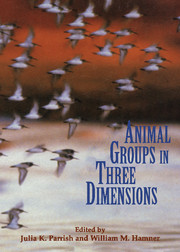Book contents
- Frontmatter
- Contents
- List of contributors
- Acknowledgments
- 1 Introduction – From individuals to aggregations: Unifying properties, global framework, and the holy grails of congregation
- Part one Imaging and measurement
- 2 Methods for three-dimensional sensing of animals
- 3 Analytical and digital photogrammetry
- 4 Acoustic visualization of three-dimensional animal aggregations in the ocean
- 5 Three-dimensional structure and dynamics of bird flocks
- 6 Three-dimensional measurements of swarming mosquitoes: A probabilistic model, measuring system, and example results
- Part two Analysis
- Part three Behavioral ecology and evolution
- Part four Models
- References
- Subject index
- Taxonomic index
5 - Three-dimensional structure and dynamics of bird flocks
from Part one - Imaging and measurement
Published online by Cambridge University Press: 01 June 2010
- Frontmatter
- Contents
- List of contributors
- Acknowledgments
- 1 Introduction – From individuals to aggregations: Unifying properties, global framework, and the holy grails of congregation
- Part one Imaging and measurement
- 2 Methods for three-dimensional sensing of animals
- 3 Analytical and digital photogrammetry
- 4 Acoustic visualization of three-dimensional animal aggregations in the ocean
- 5 Three-dimensional structure and dynamics of bird flocks
- 6 Three-dimensional measurements of swarming mosquitoes: A probabilistic model, measuring system, and example results
- Part two Analysis
- Part three Behavioral ecology and evolution
- Part four Models
- References
- Subject index
- Taxonomic index
Summary
Introduction
Of all coordinated groups of moving vertebrates, birds are at the same time the easiest to observe and perhaps the most difficult to study. While fish can be brought into a laboratory for study, and many mammals move in a two-dimensional plane, a single bird in an organized flock can move through six degrees of freedom at velocities up to 150 km/hr. Present three-dimensional analysis techniques generally demand either fixed camera or detector positions, so free-flying flocks must either be induced to fly in the field of the cameras, or the cameras must be placed in locations where there is a reasonable probability that adventitious flocks will move through the field. Perhaps because it has been so difficult to obtain data from free-flying natural flocks, there is now a current of imaginative speculation, and lively controversy, in the literature on flock structure and internal dynamics.
Birds can fly in disorganized groups, such as gulls orbiting over a landfill, or organized groups, such as the Vs of waterfowl (Fig. 5.1a). To the evolutionist, behaviorist, or ecologist, any group is of interest, but I will primarily consider only the organized groups. Heppner (1974) defined organized groups of flying birds as characterized by coordination in one or more of the following flight parameters: turning, spacing, timing of takeoff and landing, and individual flight speed and direction. The term used for such organized groups was “flight flock,” but for consistency in this volume, the term “congregation” will be used herein.
Information
- Type
- Chapter
- Information
- Animal Groups in Three DimensionsHow Species Aggregate, pp. 68 - 89Publisher: Cambridge University PressPrint publication year: 1997
Accessibility standard: Unknown
- 19
- Cited by
